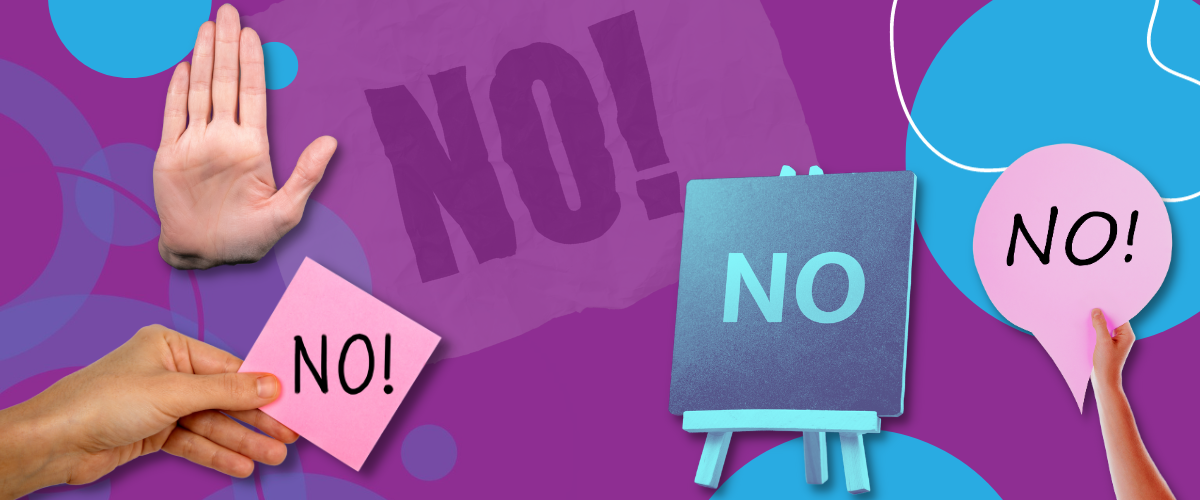Is no always no from charity donors? The 9 types of no and how fundraisers can respond
An interesting stat about face to face fundraisers is that they need an average of 80 interactions just to get a single yes. When you think about it, that’s a phenomenal amount of rejection for one person to handle in a single shift, let alone to have that on repeat for months and months. But aside from developing super human resilience, what else could fundraisers learn about this monumental number of no’s? Does no always mean no? Are there different types of no? And, more importantly, can some no’s be budged over to a yes? Let’s explore…
If only there was a kind of charity navigator magic wand that allowed us to illuminate all of the people who would likely become a donor. How much time and energy would be saved from conversing with people who aren’t ever going to give.
An experienced fundraiser knows how to preserve their resources when out on the field. They've learned how to spot the difference between someone that could be convinced and someone that's a flat no. One of the ways to track a maybe no from a proper no is by really observing what a potential donor is saying. If there's a way to void a no and switch it to a yes, then it means efforts until that point have been worth it. Nothing good ever comes easy which is why sometimes a no can be looked as an extra challenge rather than defeat.
Since not every professional fundraiser has the gift of experience, knowledge and confidence, the next best thing is to make a check list that ensure all the bases are covered and that that first no isn’t taken immediately as read.
‘The Influential Fundraiser’ by Bernard Ross and Clare Segal is a book specialising in the psychology of fundraising. Within it, Ross and Segal apply a model called the 5P which applies the five vitals for success in fundraising: Passion, Proposal, Preparation, Persuasion, and Persistence.
Fundraisers are taught the invaluable skills needed for:
Meeting specific donor challenges
Shaping ideas into effective, memorable messages
Deciding what can be gained from a particular situation
Building rapport with “difficult” or “different” people
Handling “no” responses
Creating an impact with large groups
Learning from failure
The ability to handle no responses is a fundamental part of successful fundraising. According to the chapter about handling the ‘no’ responses, there are a total of nine different types of no, along with donor interpretations and best responses for the fundraiser.
It’s really important that fundraisers remember never to disagree as such, because that just gets people defensive. Instead, agree with their point of view and seek to learn more about the objection. Essentially, the book says that if fundraisers haven’t listened in a way that tells them how to approach the ask, a no could simply be a case of ‘asking a better question’.
Of course influencing people takes increasing skill, but even the very best face to face fundraisers can’t work the crowd sometimes. Anyone in the fundraising business should remember is that sometimes, however well you deliver the pitch and however worthy the cause, the yes just won’t be possible.
However, perhaps a key difference between a fundraiser that does well and one that doesn’t is not accepting the ‘no’ as the final answer. Curiosity goes a long way, with a willingness to explore the why behind the no.
Let’s look at the 9 types of no that the ‘Influential Fundraiser’ details in the book along with some examples on a return answer:
No, not for this
The donor may tell the fundraiser they’re simply not interested in this particular cause and so won’t be giving anything.
Perhaps the ‘no’ may come out as ‘I don’t really like dogs’.
The advanced fundraiser may well then respond with
‘Oh I agree, dog’s aren’t everyone’s cup of tea. But did I tell you that our charity also helps victims of domestic abuse who aren’t leaving the relationship because they’re worried about their dog? We take care of the pet so the domestic abuse victim can sets up their new life without fearing what will happen to their dog, knowing that they’ll get their dog back once they’re ready’.
By offering up additional information, the cause is reshaped with the new focus as human need. By having a prepared answer, the fundraiser can dismantle a common objection in a completely non-confrontational way.
No, not you
Any sales person will tell you that people buy from people. That’s why it’s so important to be likeable.
But more than that, it may be that the fundraiser just isn’t someone the donor feels comfortable with. That could be because they don’t relate to them thanks to being vastly different ages or cultures.
In this instance it’s up to the fundraiser to try to bridge the gap and meet the person on their level, seeking to foster a respectful and pleasant exchange.
Finding common ground and avoiding jargon should aim to make the recipient as comfortable with a conversation as possible. Fundraisers should think about ways they can relate to their person and encourage engagement.
Of course, you may just not be able to fulfil the potential donors needs. For example, if someone is of a particular faith or cultural background they may not be willing to speak to someone of a different gender. In this instance, there’s not much you can do about it other than thank them for their time and wish them a good day.
No, not me
Sometimes you land upon a person who doesn’t consider themselves the decision maker. They might say no based on not having the authority to spend the money.
Here, a fundraiser should reassure that the money they’re looking for is a small amount. They could also try asking whether their spouse / partner (or whoever is in control of the purse strings) is around to speak with.
No, not unless
This is a conditional type of no which may be doable for a fundraiser or not.
For example, if a person says they won’t donate unless they receive xyz confirmation, then that could be easily remedied. But if they want something very specific that’s outside of a fundraisers control, it’s a hard no.
No, not in this way
This one is common objection. Opinions among the public can be that they simply don’t agree with face to face fundraisers approaching them in the first place.. A person might well be happy to donate to charity online or drop some change in a bucket, but they have a problem with being asked while out shopping. There’s also sometimes a general (and misconcieved!) mistrust in ‘chuggers’ because of bad press coverage.
The experienced fundraiser will always look to empathise, but should have statistics up their sleeves to at least re-educate the donor. For example they may say something like
‘Yes I completely agree it’s not great being asked to donate on the spot! We’re here asking for help this way because face to face fundraising is one of the most effective ways of raising funds for charity. In fact, charities rely on it because it’s such a great source of regular income that helps them plan ahead’.
Another element of ‘no, not this way’ may just be monetary; so they might want to help, just in a different way. Suggesting that they follow the charity’s social media pages, sign petitions or offer to volunteer are all ways that a fundraiser could suggest as alternatives.
Remember, supporting charity comes in many forms and it’s important to show gratitude for any help that’s offered.
No, not now
This type of no is really not about willingness, but about timing. We all have obligations, life events and circumstances that stand in the way of being able to help. Recognising this means to empathise with the potential donor, because even if they can’t give money at this point, they may well later on. Raising awareness and leaving the door open might well be enough for that person to donate when they’re able.
Another thing fundraisers can do is adjust the expectation of expense and reduce the amount a regular gift can be. Even a couple of pounds a month makes the difference and may make giving much more palitable.
An emphasis should be made on the difference every penny can make – with donors reassured that their efforts count, however small.
If it really is a no for now, then fundraisers should remain extremely pleasant and leave things on a positive note, remembering that this exchange could well be the motivation for future giving.
No, too much
Another finance based objection, ‘too much’ can be easily rectified with a drop in the amount a fundraiser is requesting. Although there is obviously an ideal amount that that the public are being asked for, anything is better than nothing.
As above, donating to charity isn’t always about money - raising awareness or volunteering for an hour can also be an incredible way to help out.
No, too little
A less common type of no – but some donors don’t feel it’s enough to ‘just’ give a few pounds a month. There are people out there who really want to make a significant contribution and really engage with the idea of raising the bar.
If a solicited amount isn’t high enough, fundraisers could always up the anti – such as offering that the donor sponsor two nurses rather than one.
Once again, it’s the fundraisers job to really drive home the difference that every donation makes and really celebrate the donor for their generosity.
No, go away
Note, this is the only ‘no’ that there’s no real come back from.
It’s a definite and absolute rejection and should be classed as such. The most important thing about this type of no is that fundraisers don't take it personally.
For a start you can never know what’s going on in someone’s’ life. and so should always be kind.
If fundraisers receive a ‘no, go away’ then the best thing they can do is use it as an excuse to exercise resilience. Aim to become a master of letting these types of no roll off like water.
A polite ‘no problem’ is the only verbal response needed here if any. Fundraisers should always remain professional and focus on not allowing someone’s rudeness to invade their peace of mind.
Interestingly, the Fundraising Regulator has recently suggested in a consultation that the strict requirement for fundraisers to be polite at all times should be removed.
The consultation reads:
“The expectation to be polite ‘at all times’ could be a problem for fundraisers facing abuse or intimidation during their work. “The revised rule could include an expectation for fundraisers to behave ‘professionally’ at all times, rather than ‘be polite’. This adjustment could allow fundraisers to respond with appropriate assertiveness to inappropriate behaviour from potential donors and the public.”
It goes on to say:
“Following the conclusion of the consultation on 1 December 2023, the Fundraising Regulator will publish a summary of responses and a new draft Code of Fundraising Practice in the first half of 2024. This will be the subject of a final eight-week public engagement exercise before being finalised. The new code is then expected to go live in early 2025.”
In the meantime, if a member of the public is unfairly rude, fundraisers should look to reach out, either to a Team Leader or fellow fundraiser to share their feelings. A problem always feels better with support!
Conclusion
A no doesn’t have to be the end, which is why it’s really important to work out what kind of no you’re getting. Look beyond the immediate reaction and think smart about what to say next. Whatever's on the menu, create a playful and pleasant response to each that makes the donor feel valued regardless of whether their offering is simply their time or a major gift.
We hope this blog has been food for thought for charity fundraisers and that you can test out a few new ways to respond to no on your next pitch. For more tips on becoming more resilient, be sure to check out our blog ‘ How to be a fundraiser with super human resilience’ which gives more key fundraising tips on surviving and thriving.





